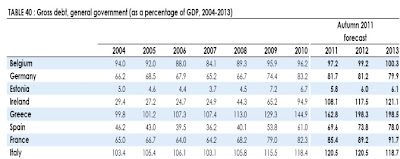Michael Burke: An article in the Irish Times by Stephen Collins which asserts that the new Treaty “seeks to do is to put an end to the kind of populist and inept fiscal policies that brought Ireland to the brink of ruin” has already drawn strong rebuttals here and here.
It is an entirely valid argument that fiscal policies brought Ireland ‘to the brink of ruin’- but only because the actual sequence of events was that it was the political decision to bail out the failed private sector banks that fatally undermined the state’s finances.
But there is no legitimacy to any suggestion that the new rules would have required successive Irish governments to act in a significantly different manner, until after the crisis hit. The table below shows that the EU commission assessed there was no structural deficit at all until 2007.
It is worth simply pointing out what the EU Commission has recorded on the Irish ‘structural deficit’.
In fact, even this low ‘structural deficit’ is dishonest. It is an example of what statisticians call ‘data-fitting’; that is, adjusting the data to get the desired outcome. Here’s what the Commission was saying in late 2008, after the crisis and the Irish slump had begun. Somehow a 2008 deficit of 4.9% has become a deficit of 7.2%.
The point of the ‘structural deficit’ is that is exceptionally malleable- it can be made to fit almost any desired level at all. In this article, the impeccably mainstream ‘Investor’s Chronicle’ magazine argues that the ‘structural deficit’ is a myth.
Nor was there a debt problem in Ireland which raised any issue regarding the 60% of GDP limit, not until 2009 for Ireland. As can be seen, it was the so-called ‘core’ countries which were the serial offenders on debt levels before the crisis.
The assertion that the new Treaty would have prevented the crisis in Ireland is groundless.




No comments:
Post a Comment